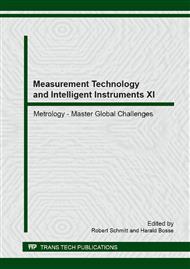[1]
N. Tiercelin, P. Coquet, R. Sauleau, V. Senez and H. Fujita, Polydimethylsiloxane membranes for millimeter-wave planar ultra-flexible antennas, J. Micromechanical Microengineering, Vol. 16, pp.2389-2395, (2006).
DOI: 10.1088/0960-1317/16/11/020
Google Scholar
[2]
S. Hage-Ali, N. Tiercelin, P. Coquet, R. Sauleau, H. Fujita, V. Preobrazhensky, P. Pernod, A millimeter-wave microstrip antenna array on ultra-flexible micromachined polydimethylsiloxane (PDMS) polymer, IEEE Antennas and Wireless Propagation Letters, Vol. 8, pp.1306-1309, (2009).
DOI: 10.1109/lawp.2009.2037590
Google Scholar
[3]
J. Kuncova-Kallio, J. Kallio Pasi, PDMS and its suitability for analytical microfluidic devices, Proceedings of the 28th IEEE EMBS Annual International Conference, pp.2486-2489, New York City, USA, Aug 30-Sept 3, (2006).
DOI: 10.1109/iembs.2006.260465
Google Scholar
[4]
J. Cooper, M.G. Whitesides, Polydimethysiloxane as a material for fabricating microfluidic devices, Accounts of Chemical Research, Vol. 35, No. 7, pp.491-499, (2002).
DOI: 10.1021/ar010110q
Google Scholar
[5]
J. W. Hong, T. Fuji, M. Seki, T. Yamamoto, I. Endo, Integration of gene amplification and capillary gel electrophoresis on a polydimethylsiloxane-glass hybrid microchip, Elecrophoresis, Vol. 22, pp.328-333, (2001).
DOI: 10.1002/1522-2683(200101)22:2<328::aid-elps328>3.0.co;2-c
Google Scholar
[6]
C. Hassler, T. Boretius, T. Stieglitz, Polymers for Neural Implants, Journal of Polymer Science: Part B: Polymer Physics, Vol. 49, pp.18-33, (2011).
DOI: 10.1002/polb.22169
Google Scholar
[7]
A. Dawson, M. Rides, J. Nottay, The effect of pressure on the thermal conductivity of polymer melts, Polymer Testing, Vol. 25, pp.268-275, (2006).
DOI: 10.1016/j.polymertesting.2005.10.001
Google Scholar
[8]
K.T. Wojciechowski, R. Zybala, R. Mania, Application of DLC layers in 3-omega thermal conductivity method, Journal of Achievements in Material and Manufacturing Engineering, Vol. 37, pp.512-517, (2009).
Google Scholar
[9]
J.L. Battaglia, C. Wiemer, M. Fanciulli, An accurate low-frequency model for the 3ω method, Journal of Applied Physics, Vol. 101, pp.104510-1, (2007).
DOI: 10.1063/1.2721389
Google Scholar
[10]
D.G. Cahill, Thermal conductivity measurement from 30 to 750 K: the 3ω method, Review of Scientific Instruments, Vol. 61, pp.802-808, (1990).
DOI: 10.1063/1.1141498
Google Scholar
[11]
D.E. Kline, Thermal conductivity studies of polymers, Journal of Polymer Science, Vol. 50, pp.441-450, (1961).
Google Scholar
[12]
I.K. Moon, H. Jeong, S.I. Kwun, The 3ω technique for measuring dynamic specific heat and thermal conductivity of a liquid or solid, Review of Scientific Instruments, Vol. 67, pp.29-35, (1996).
DOI: 10.1063/1.1146545
Google Scholar
[13]
H.S. Carslaw, J.C. Jaeger, Conduction of heat in solids, Oxford University Press, Oxford, p.193, (1959).
Google Scholar
[14]
K.J. Lee, K.A. Fosser, R.G. Nuzzo, Fabrication of stable metallic embedded in Poly(dimethylsiloxane) and model applications in non-planar electronic and lab-on-a-chip device patterning, Advanced Functional Materials, Vol. 15, pp.557-566, (2005).
DOI: 10.1002/adfm.200400189
Google Scholar
[15]
J. Hong, J. Lee, C.K. Hong, S.E. Shim, Effect of dispersion state of carbon nanotube on the thermal conductivity of poly(dimethylsiloxane) composites, Current Applied Physics, Vol. 10, pp.359-363, (2010).
DOI: 10.1016/j.cap.2009.06.028
Google Scholar
[16]
C.E. Raudzis, F. Schatz, Extending the 3ω method for thin-film analysis to high frequencies, Journal of Applied Physics, Vol. 93, pp.6050-6055, (2003).
DOI: 10.1063/1.1569663
Google Scholar
[17]
A. Jacquot, B. Lenoir, A. Dauscher, M. Stolzer, J. Meusel, Numerical simulation of the 3ω method for measuring the thermal conductivity, Journal of Applied Physics, Vol. 91, pp.4733-4738, (2002).
DOI: 10.1063/1.1459611
Google Scholar
[18]
H. Wang, M. Sen, Analysis of the 3-omega method for thermal conductivity measurement, International Journal of Heat and Mass Transfer, Vol. 52, pp.2102-2109, (2009).
DOI: 10.1016/j.ijheatmasstransfer.2008.10.020
Google Scholar


